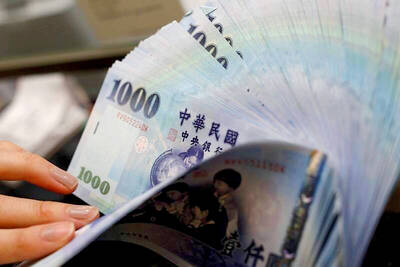Standard & Poor’s (S&P’s) yesterday said Taiwan’s GDP was expected to grow between 4.5 percent and 5 percent this year, a level equivalent to Hong Kong, but lower than in Singapore and South Korea.
Singapore’s GDP growth is projected to be between 5.5 percent and 6 percent, while South Korea will expand between 5 percent to 5.5 percent, S&P’s said in a report yesterday.
Taiwan’s Directorate-General of Budget, Accounting and Statistics revised last month the nation’s GDP growth forecast to 4.72 percent from its November estimate of 4.39 percent.
At the time, Premier Wu Den-yih (吳敦義) had said Taiwan’s GDP growth could reach 4.9 percent, higher than the global average of 2.9 percent and surpassing Japan, South Korea, Hong Kong and the US.
Meanwhile, the benchmark TAIEX could hit 8,800 points this year, S&P said. This was an increase of 7.5 percent from 8,188 points on Dec. 31 last year — the highest level in 18 months.
“Taiwan’s decision to open its borders to allow companies from mainland China to invest is a recent example of government reform that provides bilateral growth momentum,” the ratings agency said.
Growth this year is expected in all the Asia-Pacific economies, the result of a modest recovery in the US and Europe, the persisting effects of monetary and fiscal support mechanisms and gains in intraregional trade amid growing local demand, the report said.
China, India, Vietnam and Indonesia will continue to lead the pack this year, it said.
While economic prospects for the Asia-Pacific region are for the most part optimistic, some risks will continue to haunt recovery.
Inflationary concerns remain amid oil and commodity prices and higher asset prices. The latter recently showed a tendency to surge beyond levels warranted by demand-supply conditions, it said.
“Higher inflation could inspire faster rate hikes, which may in turn jeopardize the pace of the growth rebound,” it said. “Inflation may also deter recovery in private investment.”
As economic recovery in the US and Europe remains fragile, global economic stability will be a crucial factor in the revival of the Asia-Pacific, S&P said.

Merida Industry Co (美利達) has seen signs of recovery in the US and European markets this year, as customers are gradually depleting their inventories, the bicycle maker told shareholders yesterday. Given robust growth in new orders at its Taiwanese factory, coupled with its subsidiaries’ improving performance, Merida said it remains confident about the bicycle market’s prospects and expects steady growth in its core business this year. CAUTION ON CHINA However, the company must handle the Chinese market with great caution, as sales of road bikes there have declined significantly, affecting its revenue and profitability, Merida said in a statement, adding that it would

Greek tourism student Katerina quit within a month of starting work at a five-star hotel in Halkidiki, one of the country’s top destinations, because she said conditions were so dire. Beyond the bad pay, the 22-year-old said that her working and living conditions were “miserable and unacceptable.” Millions holiday in Greece every year, but its vital tourism industry is finding it harder and harder to recruit Greeks to look after them. “I was asked to work in any department of the hotel where there was a need, from service to cleaning,” said Katerina, a tourism and marketing student, who would

i Gasoline and diesel prices at fuel stations are this week to rise NT$0.1 per liter, as tensions in the Middle East pushed crude oil prices higher last week, CPC Corp, Taiwan (台灣中油) and Formosa Petrochemical Corp (台塑石化) said yesterday. International crude oil prices last week rose for the third consecutive week due to an escalating conflict between Israel and Iran, as the market is concerned that the situation in the Middle East might affect crude oil supply, CPC and Formosa said in separate statements. Front-month Brent crude oil futures — the international oil benchmark — rose 3.75 percent to settle at US$77.01

RISING: Strong exports, and life insurance companies’ efforts to manage currency risks indicates the NT dollar would eventually pass the 29 level, an expert said The New Taiwan dollar yesterday rallied to its strongest in three years amid inflows to the nation’s stock market and broad-based weakness in the US dollar. Exporter sales of the US currency and a repatriation of funds from local asset managers also played a role, said two traders, who asked not to be identified as they were not authorized to speak publicly. State-owned banks were seen buying the greenback yesterday, but only at a moderate scale, the traders said. The local currency gained 0.77 percent, outperforming almost all of its Asian peers, to close at NT$29.165 per US dollar in Taipei trading yesterday. The